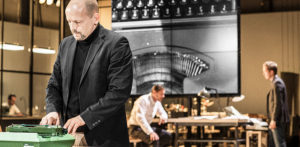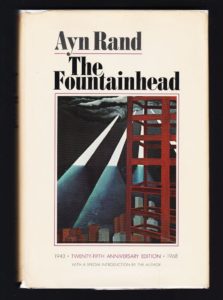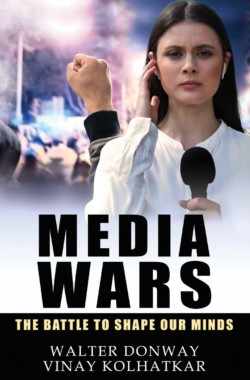“The Fountainhead” Takes the Stage: Helping or Hindering Heroism?
Reading Ayn Rand’s The Fountainhead (1943) evokes strong emotions—of love or hate—and it often changes people’s lives. Few are left indifferent.
Reading Ayn Rand’s The Fountainhead (1943) evokes strong emotions—of love or hate—and it often changes people’s lives. Few are left indifferent. This sweeping 700-page epic is the story of Howard Roark, an architect who stands by his own judgment about why, when, and how he will create. Propelled forward by his love of architecture, he faces one obstacle after another: the woman he loves, Dominique Francon, tries to destroy him; schoolmate Peter Keating simultaneously plagiarizes his work and stabs him in the back; art critic Ellsworth Toohey seeks to enslave his spirit; media mogul Gail Wynand will either break or be broken by a man of integrity.
Whatever van Hove’s own judgment of Rand’s ideas, he was moved so much by the novel that he worked for five years to secure adaptation rights for the stage.
It’s no wonder that, in 2007, a production assistant gave famed Belgian director Ivo van Hove a copy of it with the inscription: “Ivo, this is for YOU. And you have to read this NOW.” Whatever van Hove’s own judgment of Rand’s ideas, he was moved so much by the novel that he worked for five years to secure adaptation rights for the stage.
This sole play version of The Fountainhead was first performed in Holland in 2014 by Toneelgroep Amsterdam under van Hove’s direction. When they took the show on tour throughout Europe and in Korea, it received mostly favorable reviews and was hailed by The Guardian’s Andrew Todd as “electrifying theatre” that provided a “fresh and complex rereading” of Rand’s novel.

Roark and Wynand
Settling in for the four-hour show, done in four parts to mirror the novel’s structure, I hoped for the best[i]. It was visually and auditorily arresting from the beginning. Not relying on the convention of flickering houselights, the audience is summoned to attention by sledgehammer. Literally. Roark (Ramsey Nasr) slams a mallet on a pile of bricks—silencing the audience—and takes a seat at a drafting table. A projection screen located above the stage allows us to see writ large everything that occurs on that table (and sometimes, more voyeuristically, on the bed)[ii]. Roark opens a copy of the novel and begins to read from the first page.
It was visually and auditorily arresting from the beginning. Not relying on the convention of flickering houselights, the audience is summoned to attention by sledgehammer. Literally.
That’s when my first disappointment occurred, leading to my overall mixed review of van Hove’s stage version (adaptation by Koen Tachelet) of The Fountainhead. The actor utters his first line: “He stood naked at the edge of a cliff.” That’s the second line of the novel. The famous first line of this marvelous novel is “Howard Roark laughed.” This should immediately have tipped me off to something being awry, but it was nearly an hour into the play before I realized the significance of this omission. It was a sign of things to come, signaling a discrepancy between the Roark who laughed his way into my soul and the flesh-and-blood Roark who walked the stage that night.
It was a sign of things to come, signaling a discrepancy between the Roark who laughed his way into my soul and the flesh-and-blood Roark who walked the stage that night.
Before explaining my reservations about this production, let me highlight its merits.
(1) The dramatic opening was the first of many innovative uses of the set and props. Scenes flow into one another, with minimalistic set props located in different areas of the stage. Lighting is used to direct the audience’s attention to whoever is the focus at any given time. For example, as Keating (Aus Greidanus Jr.) complains to his girlfriend, Catherine (“Katie”) Halsey (Helene Devos), about how he hates architecture, we glimpse Roark busily drafting in the shadows on another part of the stage. Concurrent action gives us a realistic sense of the ongoing lives of other characters and allows more of the story to be squeezed into the stage production. (This device causes confusion at one point, though. Newspaper headlines splash across the screen to announce that the unveiling of Roark’s Stoddard Temple will not occur, and different characters take turns at a microphone addressing an unseen judge. It takes some time before those who have not read the novel grasp that Roark is on trial for building the temple.)
The already noted use of a projection screen allows the audience to see firsthand Roark’s architectural process. He stridently slashes and expertly sketches as he explains what he objects to (e.g., in the Parthenon) and what he envisions (e.g., the Heller House and the Wynand House). Kudos to the actor (Nasr) for pulling off this technically demanding feat.

Ellsworth Toohey (typing)
 (2) Toohey’s (Bart Slegers) sinister desire for power over others is cleverly captured through “showing” rather than “telling.” Right after the Intermission sign flashes on screen and the audience is about to get up, Toohey tells us that it is not Intermission time yet and the sign disappears. He then hollers, “No, don’t run off, Roark … Tell me what you really think of me.” Roark’s retorts, “But I don’t think of you,” and walks off the stage, allowing Intermission to commence. In Act IV, after the nearly dead Dominique is taken away on a gurney, Toohey nonchalantly places his typewriter on top of the blood-soaked surface to write his attack on the dynamiting of Cortlandt Homes. Toohey then stops the action a second time. Just when The End flashes on screen after Wynand’s suicide, Toohey walks on stage and launches into his final speech. Directly addressing the audience, he lectures how society must rid itself of the selfish individual. Between his unconcern for bloodshed and twice hijacking the audience with a fake intermission and fake ending, we experience what Toohey is all about: power. This should make us feel uncomfortable—and in more ways than just being kept from using the bathroom at the two-hour and four-hour marks.
(2) Toohey’s (Bart Slegers) sinister desire for power over others is cleverly captured through “showing” rather than “telling.” Right after the Intermission sign flashes on screen and the audience is about to get up, Toohey tells us that it is not Intermission time yet and the sign disappears. He then hollers, “No, don’t run off, Roark … Tell me what you really think of me.” Roark’s retorts, “But I don’t think of you,” and walks off the stage, allowing Intermission to commence. In Act IV, after the nearly dead Dominique is taken away on a gurney, Toohey nonchalantly places his typewriter on top of the blood-soaked surface to write his attack on the dynamiting of Cortlandt Homes. Toohey then stops the action a second time. Just when The End flashes on screen after Wynand’s suicide, Toohey walks on stage and launches into his final speech. Directly addressing the audience, he lectures how society must rid itself of the selfish individual. Between his unconcern for bloodshed and twice hijacking the audience with a fake intermission and fake ending, we experience what Toohey is all about: power. This should make us feel uncomfortable—and in more ways than just being kept from using the bathroom at the two-hour and four-hour marks.
(3) Keating’s pathetic and Katie’s heartbreaking parallel spirals into unhappiness are well done. An extra scene with them has even been added that is not in the novel, which draws out and underscores their sad transformation from a young, engaged couple to embittered, alienated acquaintances. They have both been touched, albeit in different ways, by the withering hand of Toohey. Their lives show us what happens when one lives according to the altruist creed that Toohey preaches.
(4) This Dutch-spoken play with English sur-titles chose to render Rand’s phrase “self-sufficient ego” in the sur-title as “autarky.” This is an ancient Greek word, found especially in Aristotle’s ethics that means “sufficient in oneself, independent of others.” There is thus one word to capture what Roark and Wynand seek as an alternate to “selfishness” or “egotism,” which they lament “have been perverted … to mean Peter Keating.”
Now for my reservations. I understand that van Hove is an artist with his own purpose for bringing The Fountainhead to life on stage. He is taken by Rand’s theme of integrity versus compromise: “It is a central issue for an artist … Do you want to follow your ideals or do you give the audience what you think they want?” It’s good that he grasps this conflict and makes this “war of ideas” central to the play. In following his ideals and giving the audience what he wants, though, he distorts Rand’s vision in (at least) three major ways.
Van Hove creates a paradox, where Rand doesn’t see one, of artistic integrity versus commercial success. Roark’s not caving in to what others want is presented as a rejection of market pressure (which reflects van Hove’s resistance to capitalism in favor of the welfare state). It is significant that in the play we do not directly see Roark succeed.
(1) Van Hove creates a paradox, where Rand doesn’t see one, of artistic integrity versus commercial success. Roark’s not caving in to what others want is presented as a rejection of market pressure (which reflects van Hove’s resistance to capitalism in favor of the welfare state). It is significant that in the play we do not directly see Roark succeed. When he does—as with securing the Enright House commission—it’s something that we infer. The play also lacks the novel’s second trial. Instead, after Wynand’s suicide (followed immediately by the fake ending), it ends with Toohey and then Roark speaking to the audience. They offer their views, respectively, on altruism/collectivism and egoism/individualism: Do you live for others or for yourself? The audience is tasked with deciding who ultimately wins.
(2) Key parts of dialogue are missing from two scenes, both involving Roark and Keating. When Keating is trying to decide after graduation whether to work for Guy Francon (Hugo Koolschijn, who also plays Henry Cameron), Roark doesn’t tell Keating (as he does in the novel) never to ask anyone else about one’s own work, that he should know what he wants. Instead, he tells Keating that Francon is a fool but at least Keating will get to build by working for him. Later, Roark assures Keating that he can have all the credit, fame, and money if only he promises to build Cortlandt Homes exactly as Roark designs it. However, Keating is not shown (as he is in the novel) affirming that Roark gets the better deal in being able to see his own work brought into existence. These omissions share the insight that man’s self-esteem comes from efficaciously using one’s own judgment.

Peter Keating and Dominique
Those who love Rand’s The Fountainhead will be divided over the merits of van Hove’s stage adaptation. Some parts are innovative and effective. And it’s heartening that serious artists are taking her work seriously for some of the right reasons. Given the adaptation, all of the actors—of both major and minor characters—gave compelling performances.
Those who love Rand’s The Fountainhead will be divided over the merits of van Hove’s stage adaptation. Some parts are innovative and effective. And it’s heartening that serious artists are taking her work seriously for some of the right reasons. Given the adaptation, all of the actors—of both major and minor characters—gave compelling performances. Nasr conveys Roark’s passionate devotion to principle, Reijn disturbingly captures Dominique’s tormented psyche, Greidanus gives us a childishly petulant Keating, Slegers’s Toohey is rightfully chilling, and Kesting strides convincingly as the commander of Wynand’s empire. However, there are reasons for concern.
Given the drawbacks of the adaptation, those who enter the darkened theater already disliking Rand’s work will feel vindicated, especially in how Roark is enacted. One can see this in the snarky reviews of the play in several NYC media outlets, though these reviewers spend more time smearing Rand’s ideas than assessing the performance. Critics scoff at “Rand’s architectural superman” who allegedly embodies “sub-Nietzschean philosophical pretension.” They puzzle over how van Hove can squander his talent on giving center stage to an “Objectivist fairytale” where a “pouting,” “whining” Roark gets to enact “some sort of ‘Twilight of the Gods’ fantasy.” (Never mind that Rand admired Aristotle and explicitly rejected Nietzsche, but that assumes the critics care about getting her right.)
On the other hand, they will be exposed to some thought-provoking ideas, perhaps spurring them to read the novel and judge for themselves. That’s where Rand’s projection of an “ideal man” lifts off the page and walks about in the theater of our mind.
Those who attend the play without having read The Fountainhead could easily be confused about why so many people love Rand’s work. In being deprived of the vision of a serenely happy Roark, who ultimately succeeds and for whom any suffering “goes down only to a certain point,” they are getting an incomplete picture of her philosophy. On the other hand, they will be exposed to some thought-provoking ideas, perhaps spurring them to read the novel and judge for themselves. That’s where Rand’s projection of an “ideal man” lifts off the page and walks about in the theater of our mind.
While I have no desire to see van Hove’s production again, I now have a greater appreciation of the difficulties involved in adapting Rand’s epic novel to the stage. If someone else—one who is authentically an artist and embraces Rand’s worldview—were to attempt a new adaptation, I’d give it a hopeful try. Until such time, I will return to my lovingly dog-eared copy of The Fountainhead for “the courage to face a lifetime” (another favorite scene of mine, omitted from the play). For there is where I find Roark as Rand presents him, the character who laughingly inhabits the sunlit region of my imagination beyond stage or screen.
Call me an old-fashioned romantic, but I’ll take my heroes happy[v].
______________________________________________________________________________________________________________________________________________________________________________________________
[i] The novel’s Part I: Peter Keating is re-named “Idea Factory,” Part II: Ellsworth M. Toohey is re-named “Love and Labor,” Part III: Gail Wynand is re-named “Valhalla,” and Part IV: Howard Roark is re-named “War of Ideas.” These re-namings are apt. Keating approaches his work as though churning out meaningless pre-fabricated homes on an assembly line. Dominique first falls in love with a laboring Roark, while love and work are the two sources of meaning that Toohey seeks to extinguish in individuals the better to control them. Wynand rules over his media empire from atop a massive, 57th-floor penthouse as though he were Odin waiting to slay combatants. Roark heroically faces various adversaries in a perennial clash of philosophies.
[ii] Full disclosure, I walked out of the November 30th performance of the play about 75 minutes into the production because I felt ambushed by graphic full-frontal nudity (of both Roark and Dominique), which was not warned about in BAM’s advertising. I was persuaded to return on December 2nd to view the entire production. Space constraints allow me to note only that the notorious “rape scene” was done with clothes on—which was highly effective—and I found subsequent nudity offensive and unnecessary.
[iii] Rand approved a similar change when her novel was adapted for King Vidor’s 1949 film version of The Fountainhead. It is difficult (though not impossible) to convey metaphorical suicide through visual media, so adapting Wynand’s “suicide” this way is understandable. However, this choice diminishes both the grandeur of Wynand’s character and the tragedy of his ultimate self-betrayal. In the novel, Wynand realizes the egregious nature of his decision to “give in,” so he also knows that he deserves to suffer the ultimate punishment for it: having to peer grimly into the mirror every day for the rest of his life in full awareness of his treason. Committing literal suicide is the easy way out.
[iv] The characters of Guy Francon and John Erik Snyte in the novel are compressed into the character of Guy Francon in the play.
[v] I am grateful to Robert Begley, Paul Blair, Ann Ciccolella, Pooja Gupta, Kevin Hill, Vinay Kolhatkar, Brishon Martin, Shoshana Milgram, Donna Paris, Raymond Raad, Rebecca Reale, Gregory Salmieri, and Michael Shapiro for thought-provoking discussions about and comments on earlier versions of this review.
« I Am Whatever Race I Say I Am! I was a Hippie. Then I Encountered Ayn Rand … »










